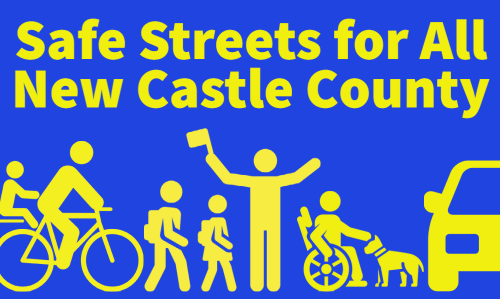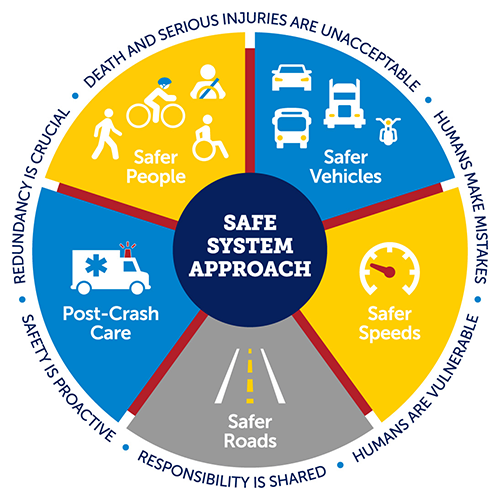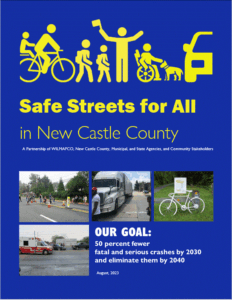Safe Streets for All in New Castle County, DE
A Vision Zero Plan to Eliminate All Transportation Deaths and Severe Injuries
Our Goal: Fewer Injuries and Zero Deaths
What’s New
Learn about Safe Streets for All in Cecil County – https://www.ccgov.org/about-us/strategic-highway-safety-plan
New Castle County Safety Action Plan:
Final Report – Endorsed September 14, 2023
View results of the public outreach
- Survey Results:
https://docs.google.com/forms/d/1URUr4eVI37Zf3CQOO34Gh5g1hveDiRoU1ULFo39BBn4/viewanalytics - Interactive Map Comments:
https://www.google.com/maps/d/u/0/edit?mid=1hx6HcQ7FYSRiPX6fRwAqlU7_F6ZCZDE&usp=sharing
View the High Injury Crash Network map:
Draft Report:
- 8/17 – WILMAPCO Technical Advisory Committee
- 9/1-9/7 – Document edits from public review
- 9/14 – WILMAPCO Council adoption
Community survey and interactive map were available between 3/9 – 5/14
View results of the public outreach
- Survey Results: https://docs.google.com/forms/d/1URUr4eVI37Zf3CQOO34Gh5g1hveDiRoU1ULFo39BBn4/viewanalytics
- Interactive Map Comments: https://www.google.com/maps/d/u/0/edit?mid=1hx6HcQ7FYSRiPX6fRwAqlU7_F6ZCZDE&usp=sharing
- View the High Injury Crash Network map: https://www.scribblemaps.com/maps/view/ss4a/ss4adraft
What is Safe Streets for All New Castle County
Safe Streets for All in New Castle County is a collaborative initiative to eliminate roadway deaths and severe injuries in our communities. WILMAPCO, local governments, state agencies, and community stakeholders will develop an action plan to identify how we can collectively achieve zero fatalities.
In 2022, a record 86 people died on New Castle County streets. This loss is unacceptable. These are mothers, fathers, sons, daughters, husbands, wives, friends, neighbors, and colleagues. Their loss exacts a serious toll, including emotional trauma, healthcare expenses, wage and productivity losses, and significant taxpayer spending on emergency response.

Principals of Vision Zero

Deaths and serious injuries are unacceptable: Traffic safety solutions, based on data-driven strategies, must have a zero-tolerance approach to injury prevention. The goal is to modify how users, vehicles, transportation infrastructure, and emergency response operations to reduce the likelihood of crashes happening at all, and to reduce their severity when they do happen.
People make mistakes: People will inevitably make mistakes that can lead to crashes, but we can design and operate the roadway system to accommodate human mistakes to avoid death and serious injuries.
The human body is fragile: Pedestrians and bicyclists are particularly vulnerable to death and injury, and that risk decreases on slower-speed streets.
We share responsibility: Transportation users should ideally follow the rules of the road, but that wish alone won’t solve this challenge. Rather, decision-makers must make funding and policy decisions that prioritize safety, engineers and planners must build communities safer for walking, bicycling, transit users, and drivers, educators must instill safe behavior in their messaging, and first responders need to provide the best enforcement and medical response activities.
Safety is proactive: Decisions should be made using crash-based analysis and other tools to identify and mitigate latent risks in the roadway system, rather than waiting for crashes to occur and reacting afterward.
Redundancy is crucial: Reducing risks requires that all parts of the roadway system are strengthened so that if one part fails, people are still protected. Safe System approach elements are Safe Road Users, Safe Vehicles, Safe Speeds, Safe Roads, and Post-Crash Care.


